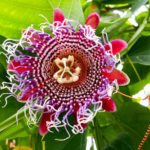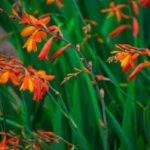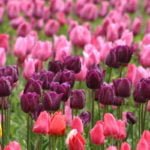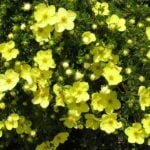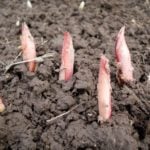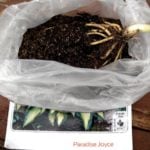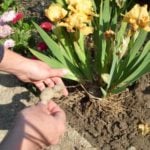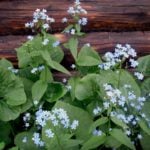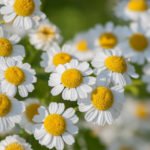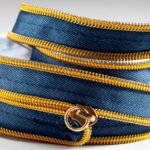This herbaceous perennial has something to surprise you: the unpretentiousness, expressive appearance and versatility in use make it a welcome guest in any garden.
Bergenia cordifolia has been recognized in Europe as a herbaceous perennial of 2017. Ironically, many of our gardeners “name” of this plant says little. It’s time to fill in the blanks! Let’s find out why he is considered so outstanding!

Bergenia looks great and feels great in the pot. You will need a container with a diameter of at least 30 cm and a plant of compact variety.
To begin with, Bergenia is virtually maintenance-free and can grow in the same place for decades. Experts advise unless to divide the plant every 7-8 years. This herbaceous perennial feels great both in the sun and in the shade. However, with an abundance of light Bergenia blooms much more luxuriant, and the color of the leaves in this case brighter. As for the soil, the main requirement of Bergenia is its good water permeability. And finally, the main “prize”: perennials perfectly winters under the snow without shelter!
So, with the disposition of the ward undecided. Now let’s figure out — and it is Bergenia decorative to grant him a “living space” in the garden? The answer is unspeakably delight: our hero is not only spectacular blooms in may and June, but has blue grey leaves. Moreover, the fleshy “webs” of Bergenia after the first autumn frosts are painted in a spectacular red color, decorating the plant throughout the snow-free season, often until flowering. Only after that the old leaves are gradually replaced by new ones. Accordingly, Bergenia is beautiful all year round.

Spring gift garden — tall and powerful inflorescence of Bergenia is best suited for cutting. White flowers SCHNEEKÖNIGIN, as they open, become pale pink.
Varieties Of Bergenia
Note that on the basis of heartwood Bergenia derived many different varieties.

Baby Doll-variety with lovely pink flowers, which is great for planting on the edge of the flower garden, and for growing in a potty.
There are even beautiful repairmen who re-bloom in the second half of the summer. These include, for example,’ Doppelgänger ‘with purple flowers and’ Herbstblüte ‘ — with rich pink. The latter leaves in the cold season remain green, as in ‘Schneekönigin’, so both these plants will be good partners for their fellow, dressed in red foliage outfit.

David Bergenia boasts dazzling bright pink flowers, thanks to which it can be seen from afar. In autumn, the leaves are painted in at least a catchy red color.
Important: Bergenia flowers of early varieties often turn black due to the defeat of late spring frosts, so for regions with a cold climate it is better to choose late-flowering varieties, such as ‘Oeschberg’ and ‘Eroica’.

1. Bergenia ciliata belongs to those rare species that shed their leaves in winter. He prefers shady places in the garden.
2. Pink Dragonfly pale pink flowers later acquire a salmon-pink hue. In autumn, the leaves of the plant are colored in a rich red color.
3. Abendglocken was bred in the middle of the last century. In the spring of Bergenia, this variety is decorated with dense brushes of purple flowers, similar to bells.

4. Biedermeier-compact plant with a height of only 30 cm with light pink large flowers-bells.

5. Covered with frost the leaves of Bergenia — a spectacular sight. Red-green webs of plants enliven the black-and-white winter flower beds.
6. Eroica is considered one of the best varieties. Against the background of yellow-green milky Segier purple-red flowers of this Bergenia look particularly advantageous. With the onset of cold weather leaves become red.
7. Oeschberg also autumn and winter leaves attract attention catchy color, and in the spring the plant is decorated with inflorescences with pink flowers.
The flower garden Bergenia best combined with less massive floral herbaceous perennials, such as Aquilegia, astrance, Japanese anemone, daylily and astilba. It also looks great in an ensemble with filigree decorative herbs, such as meadow and big hornblood. Isn’t it enough to admit that Bergenia is worthy of his “title” and your attention!

Bergenia is an excellent border plant. It is especially good in flower beds, broken along the tracks.
Diseases and pests
Bergenia is a very hardy plant. However, the soil is too wet it can suffer from fungal diseases such as ramularia. In the cluttered perennial on the leaves appear clearly defined dark spots, and on the bottom side of them — whitish plaque. To save ” pet ” from misfortune will help processing copper-containing drugs.
Among pests chief enemy Bergenia-weevil. It eats leaves around the outer edges. But the beetles themselves are not as dangerous as their larvae feeding on the roots of the plant. To overcome this pest can be using special drugs (if you are against chemistry, use special soil nematodes, adding them to the water for irrigation).
Tip: spring is necessary to remove all the blackened leaves under them, as a rule, weevils overwinter.
Reproduction and transplantation
Share and seat too overgrown Bergenia need or early spring or autumn. Rejuvenated after such a procedure, the herbaceous perennial will thank for caring for the rapid growth and abundant flowering.
Transplant Bergenia can also be immediately after flowering. But it should be shortened leaves and in the first few weeks after planting to ensure that the soil is not dry (especially if the beginning of the summer was dry and hot). In autumn, the soil under the plant is desirable to mulch with compost – it will protect the roots that are close to the surface from the cold and at the same time will become a dressing for the “pet” next season.



